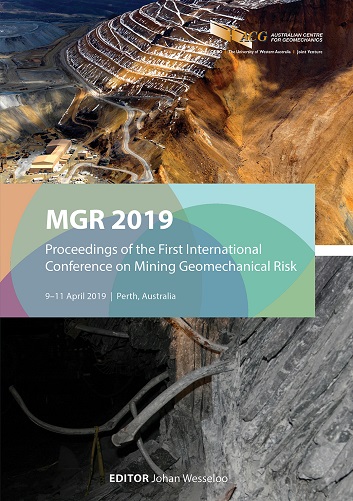InSAR tools for risk assessment over mine assets

|
Authors: Morgan, JL; Colombo, D; Meloni, F |
DOI https://doi.org/10.36487/ACG_rep/1905_06_Morgan
Cite As:
Morgan, JL, Colombo, D & Meloni, F 2019, 'InSAR tools for risk assessment over mine assets', in J Wesseloo (ed.), MGR 2019: Proceedings of the First International Conference on Mining Geomechanical Risk, Australian Centre for Geomechanics, Perth, pp. 159-170, https://doi.org/10.36487/ACG_rep/1905_06_Morgan
Abstract:
Ground motion over mine sites, while an everyday occurrence, may represent hazards that need to be identified and monitored over time. An accurate and regularly updated overview of surface movement over mining operations is therefore critical as part of an ongoing risk assessment program. By having a complete picture of ground stability, movement patterns which represent potential geotechnical hazards to safety and mine operations can be identified and tracked over time. From routine monitoring to highfrequency updates, interferometric synthetic aperture radar (InSAR) technology is increasingly being used to identify a wide range of movement patterns which may be of concern to mine operators and geotechnical engineers. Recent advances in radar image processing algorithms, combined with an increase in the number of satellite systems launched into orbit, have resulted in improvements in the ability of this technology to capture complex and rapid displacement. In particular, the ability to characterise rapid and sudden motion (metres of movement) has increased the utility of InSAR from a practical standpoint in characterising geotechnical hazards. Further exploitation of 2D monitoring approaches in capturing vertical and horizontal movement, particularly for producing displacement vectors along cross sections, can also provide additional insights into hazard characterisation. Key differences between the ability of highresolution imagery to capture complex and rapid deformation in comparison to low-resolution (but freely available) Sentinel imagery are also touched upon. This paper will focus on the practical application of InSAR technology to monitor mine sites around the world, illustrating how new processing approaches and data sources are used in the identification of geomechanical risks that are typically of greatest concern from both an operational and safety standpoint. Examples of results over an active mine site will be shared and a particular emphasis will be placed on selecting the right InSAR tool for helping geotechnical engineers best manage risk due to movement.
Keywords: open pit, InSAR, slope stability, tailings dam, hazard mapping, displacement monitoring, radar imagery, SAR, deformation maps, surface profiles, displacement vectors
References:
Colombo, D & MacDonald, B 2015, ‘Using advanced InSAR techniques as a remote tool for mine site monitoring’, Proceedings of the International Symposium on Slope Stability in Open Pit Mining and Civil Engineering 2015, The Southern African Institute of Mining and Metallurgy, Johannesburg.
Ferretti, A, Prati, C & Rocca, F 2001, ‘Permanent scatterers in SAR interferometry’, IEEE Transactions on Geoscience and Remote Sensing, vol. 39, no. 1, pp. 8–20.
Ferretti, A, Fumagalli, A, Novali, F, Prati, C, Rocca, F & Rucci, A 2011, ‘A new algorithm for processing interferometric data-stacks: SqueeSAR’, IEEE Transactions on Geoscience and Remote Sensing, vol. 49, no. 9, pp. 3460–3470.
Ferretti, A, Savio, G, Barzaghi, R, Borghi, A, Musazzi, S, Novali, F, Prati, C & Rocca F 2007, ‘Sub-millimeter accuracy of InSAR time series: Experimental validation’, IEEE Transactions on Geoscience and Remote Sensing, vol. 45, no. 5, pp. 1142–1153.
Massonnet, D & Feigl, KL 1998, ‘Radar interferometry and its application to changes in the Earth's surface’, Reviews of Geophysics, vol. 36, no. 4, pp. 441–500.
Paradella, WR, Ferretti, A, Mura, JC, Colombo, D, Gama, FF, Tamburini, A, Santos, AR, Novali, F, Galo, M, Camargo, PO, Silva, AQ, Silva, GG, Silva, A & Gomes, LL 2015, ‘Mapping surface deformation in open pit iron mines of Carajas Province (Amazon region) using an integrated SAR analysis’, Engineering Geology, vol. 193, pp. 61–78.
Peltier, A, Bianchi, M, Kaminski, E, Komorowski, JC, Rucci, A & Staudacher, T 2010, ‘PSInSAR™ as a new tool to monitor pre-eruptive volcano ground deformation: validation using GPS measurements on Piton’, Geophysical Research Letters, vol 37, issue 12.
Savio, G, Ferretti, A, Novali, F, Musazzi, S, Prati, C & Rocca, F 2005, ‘PSInSAR validation by means of a blind experiment using dihedral reflectors’, in W Osten (ed.), The 5th International Workshop on Automatic Processing of Fringe Patterns, Springer, Leipzig.
© Copyright 2026, Australian Centre for Geomechanics (ACG), The University of Western Australia. All rights reserved.
View copyright/legal information
Please direct any queries or error reports to repository-acg@uwa.edu.au
View copyright/legal information
Please direct any queries or error reports to repository-acg@uwa.edu.au
